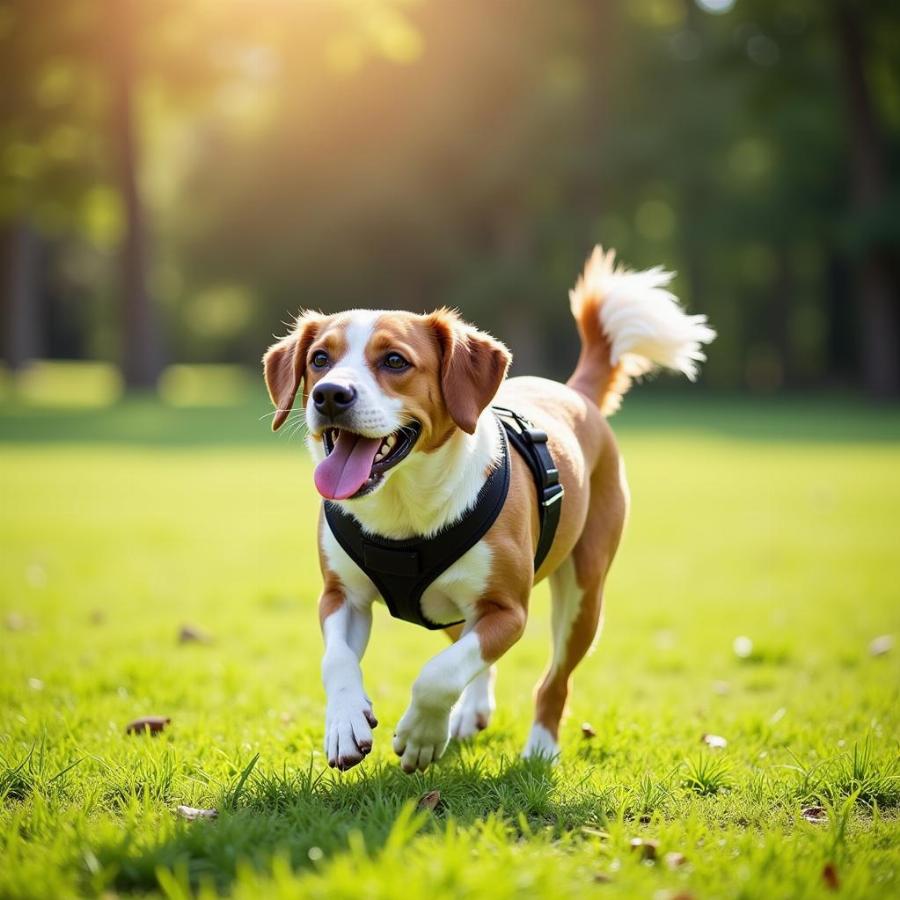A no escape harness for dogs is a crucial piece of equipment for any pet owner, especially those with adventurous or anxious pups prone to slipping their collars. This guide explores everything you need to know about no escape harnesses, from choosing the right type and size to ensuring a comfortable and secure fit. We’ll delve into the benefits, address common concerns, and help you make the best decision for your furry friend.
Understanding the Importance of a No Escape Harness
 Chó đang đeo dây nịt không thoát được, vui vẻ chạy nhảy trong công viên
Chó đang đeo dây nịt không thoát được, vui vẻ chạy nhảy trong công viên
Traditional collars can pose a choking hazard, particularly for dogs who pull or lunge. They can also be easily slipped out of, leading to potentially dangerous situations. A no escape harness, on the other hand, distributes pressure evenly across the chest and back, reducing strain on the neck and preventing escape. This is especially beneficial for dogs with respiratory issues or delicate tracheas.
Choosing the Right No Escape Harness for Your Dog
With a variety of no escape harnesses available, selecting the perfect one for your dog can seem daunting. Consider your dog’s breed, size, activity level, and any specific needs. cute dog harness might be a good starting point for small breeds.
Types of No Escape Harnesses:
- Front-Clip Harnesses: These harnesses feature a leash attachment point on the chest. When your dog pulls, the harness gently steers them back towards you, discouraging pulling behavior.
- Back-Clip Harnesses: These harnesses have a leash attachment on the back, providing more freedom for dogs who walk nicely on a leash.
- Dual-Clip Harnesses: Offering both front and back leash attachments, these harnesses provide versatility for training and everyday walks.
- Step-in Harnesses: Easy to put on, these harnesses are ideal for dogs who dislike having things pulled over their heads. full body harness for dogs provides full-body support and security.
Sizing and Fit:
Proper fit is essential for both comfort and effectiveness. Measure your dog’s chest girth and neck circumference accurately and refer to the manufacturer’s size chart. large harness for dogs would be suitable for larger breeds. The harness should be snug but not restrictive, allowing for two fingers to fit between the harness and your dog’s body.
Training Your Dog to Wear a No Escape Harness
Introduce the harness gradually, rewarding your dog with treats and praise. Start by letting your dog sniff and explore the harness. Then, try putting it on for short periods, gradually increasing the duration as your dog becomes more comfortable.
Addressing Common Concerns about No Escape Harnesses
Chafing:
While rare, chafing can occur if the harness doesn’t fit properly or is made of abrasive materials. Ensure a proper fit and opt for harnesses with padded straps. yellow dog harness can add a touch of style while providing comfort.
Restricted Movement:
A correctly fitted no escape harness should not restrict your dog’s natural movement. Choose a harness designed for your dog’s activity level, allowing for a full range of motion.
Expert Insights on No Escape Harnesses
Dr. Emily Carter, DVM: “No escape harnesses are an excellent choice for dogs of all breeds and sizes. They provide safety and control while minimizing the risk of injury.”
Jane Miller, Certified Dog Trainer: “I recommend no escape harnesses for my clients, especially those struggling with leash reactivity. The added control and security can make a significant difference in training and walks.”
Is a No Escape Harness Right for My Dog?
If you’re looking for a safe, comfortable, and effective way to walk your dog, a no escape harness is an excellent option. best escape proof dog harness provides ultimate safety.
Conclusion: Securing Your Furry Friend with a No Escape Harness
A no escape harness is a valuable investment in your dog’s safety and well-being. By choosing the right type, ensuring a proper fit, and introducing the harness gradually, you can provide your dog with a comfortable and secure walking experience.
FAQ: Your Questions About No Escape Harnesses Answered
- Q: Can a no escape harness be used for puppies? A: Yes, no escape harnesses are available for puppies and can help establish good leash manners from a young age.
- Q: Are no escape harnesses suitable for all breeds? A: Yes, no escape harnesses can be used for dogs of all breeds, sizes, and activity levels.
- Q: How do I clean a no escape harness? A: Most no escape harnesses can be hand washed or machine washed on a gentle cycle. Refer to the manufacturer’s instructions for specific cleaning guidelines.
- Q: Can a no escape harness prevent my dog from pulling entirely? A: While a no escape harness can discourage pulling, consistent training is still essential for optimal leash manners.
- Q: What is the difference between a no-pull harness and a no escape harness? A: A no-pull harness is designed to discourage pulling, while a no escape harness focuses on preventing the dog from slipping out of the harness. Some harnesses combine both features.
- Q: Where can I buy a no escape harness? A: No escape harnesses are available at pet stores, online retailers, and from some veterinarians.
- Q: My dog seems uncomfortable in their new harness. What should I do? A: Ensure the harness is fitted correctly and try adjusting the straps. If your dog continues to show signs of discomfort, consult a veterinarian or professional dog trainer.
More Questions? Explore These Related Articles
No related articles found.
Beaut Dogs: Your Trusted Source for Dog Care Information
Beaut Dogs is your go-to resource for reliable and insightful information on all things dog-related. We provide expert advice on breed selection, care, training, and more. When you need assistance, reach out to us via Email: [email protected] to get detailed and accurate answers from Beaut Dogs.